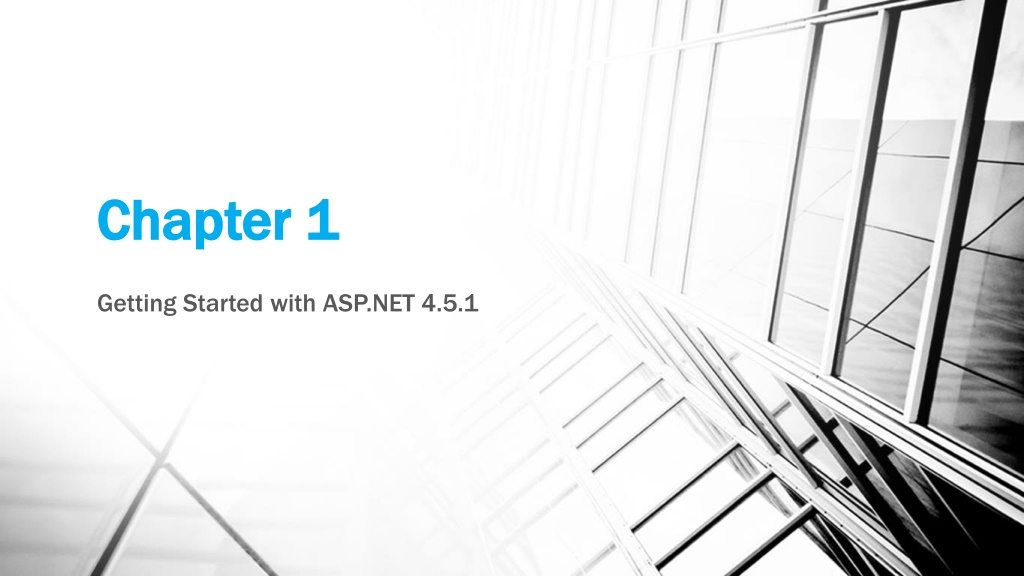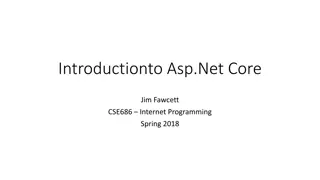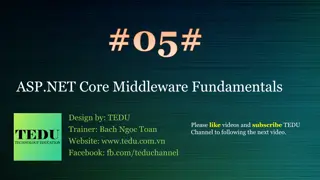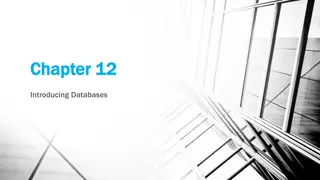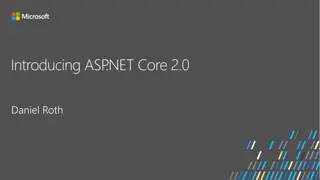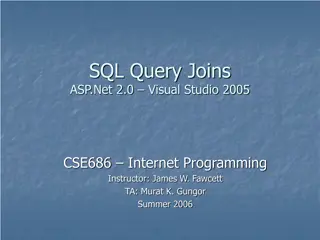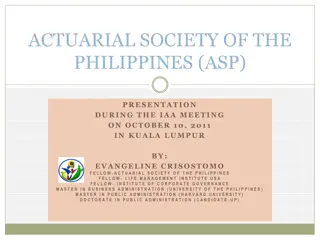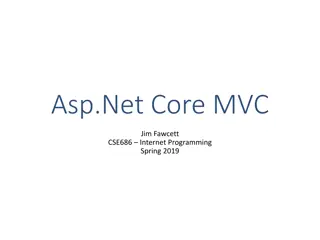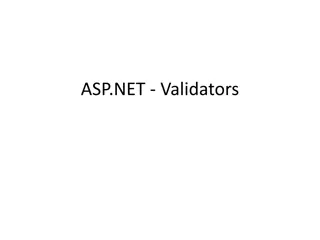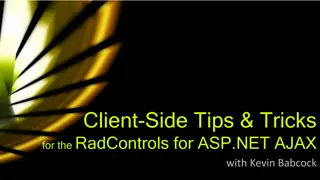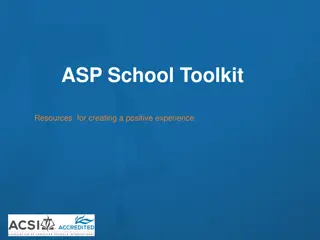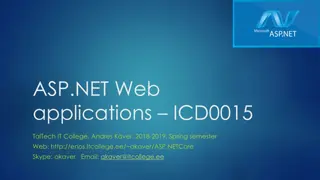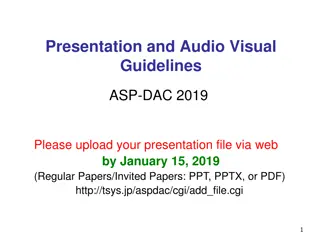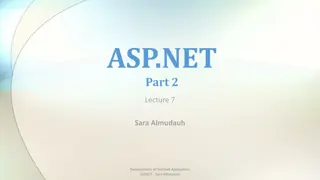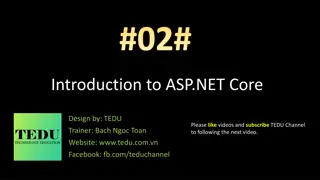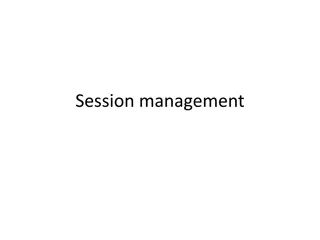Introduction to ASP.NET 4.5.1 - Building Dynamic Websites
Explore the fundamentals of ASP.NET 4.5.1, learn about the benefits of using ASP.NET for web development, understand the difference between static and dynamic websites, and discover the features of ASP.NET that make it a powerful web runtime engine. Get started with creating a new website using Visual Studio and the .NET Framework, and delve into essential concepts such as HTML controls and C# programming.
Download Presentation

Please find below an Image/Link to download the presentation.
The content on the website is provided AS IS for your information and personal use only. It may not be sold, licensed, or shared on other websites without obtaining consent from the author.If you encounter any issues during the download, it is possible that the publisher has removed the file from their server.
You are allowed to download the files provided on this website for personal or commercial use, subject to the condition that they are used lawfully. All files are the property of their respective owners.
The content on the website is provided AS IS for your information and personal use only. It may not be sold, licensed, or shared on other websites without obtaining consent from the author.
E N D
Presentation Transcript
Chapter 1 Chapter 1 Getting Started with ASP.NET 4.5.1
Objectives Objectives Why ASP? To get familiar with our IDE (Integrated Development Environment ), Visual Studio. Understand how to create a new Website with the .NET Framework. Write a simple Hello World Program Look at some HTML Controls Review an ASP.NET control
Why ASP.NET Why ASP.NET Websites have gone from being static to being dynamic. A static site stays the same no matter how many times your request it and contains HTML elements: Example: http://users.cis.fiu.edu/~aleroque/COP4813/index.html A dynamic site changes depending on user input and changes ever time. Example: https://www.amazon.com/ There are frameworks out there that facility the building of dynamic sites: Java Servlets, PHP, Ruby. And ASP.NET
Why ASP.NET Why ASP.NET ASP.NET is a free, powerful web runtime engine. It accelerates web development by providing feature rich controls. Clear separation of look and feel (.aspx) and the programmability (aspx.cs) HTTP is a Stateless protocol (it doesn t remember the state it was last in after a network trip). ASP.NET takes care of this for us with a mechanism to handle state (ViewState). Features many controls that provide a lot of built in features.
Our IDE Our IDE It is our primary Tool for creating an application. It supports different types of Projects , which the shell for the overall program that we want to create. It also supports a website structure. We will always work with C#. C# is a more marketable and more powerful programming language. We will also work with HTML and become familiar with the different HTML controls. For a reference of HTML Tags, go to http://www.w3schools.com/tags/default.asp
How to create a new website How to create a new website Create a Website by hitting File -> New - > Web Site and select .NET framework 4.5.1 (or latest). Select from the templates ASP.NET Web Forms You now have a default website structure. We can add or change files as necessary Open the default.aspx and add the following code under the asp:Content tag <h2>Hello World</h2> <p>Welcome to ASP.NET on <%: DateTime.Now.ToString() %></p>
Output is Output is
What happened What happened We created a new website under the .NET Framework with the template of ASP.NET forms The template create some default files and we opened up the default.aspx file. Default.aspx is actually two files bound together. Default.aspx Default.aspx.cs Default.aspx.cs Default.aspx and The aspx file is known as the markup file. We work with HTML elements here and ASP controls. The aspx.cs file is known as the code behind file is where we add programmability for our web file. You can also use the <% %> in the markup to add code.
What happened What happened The tags/controls on the markup file (aspx) get rendered to display the page. The <% %> tags treat anything between them like code to compile and process. The C# code DateTime.Now.ToString() dynamically generates the time on the server side. But what do we mean by on the server side???
Introduction to ASP.NET 4.5.1 Introduction to ASP.NET 4.5.1 When we type a URL in a web browser, a request is sent to a web server through the HTTP (HyperText Transfer Protocol). The URL (www.something.suffix/resource) is translated into an IP address and port, which is received by a web server. When the server accepts the request, it processes it and sends back a response. For static files (files that do not change regardless of the request) the web server finds the resources and sends them back For dynamic files (aspx) the web server maps the request to another software that can handle it, namely the ASP.NET runtime
Introduction to ASP.NET 4.5.1 Introduction to ASP.NET 4.5.1
What can influence how the page displays What can influence how the page displays Static Text: Text like HTML,CSS or Javascript is sent to the browser directly. ASP.NET Server Controls: These controls are in your .aspx page and when they are processed by the web server, they emit HTML code For example, the asp.net textbox control <asp:TextBox runat="server" Text="my value"></asp:TextBox> Becomes <input name="ctl00$MainContent$ctl00" type="text" value="my value"> Programming Code: This is the area where you can add you C# or VB programmability. You can do this in the markup or preferably in the source file. DateTime.Now.ToString()
Understanding HTML Tags Understanding HTML Tags We can review the HTML tags in W3Schools http://www.w3schools.com/tags/default.asp Some of the common ones we use are: <html>: Defines the start of the entire html page <title> : Defines the title of the page <body> : Denotes the start of the body where the main content goes <header>: Denotes the start of the header <a>: Anchor, used to create hyperlinks to other resources <img>: Used to display an image <form>: Used for input forms that submit information from user to server <table>: Creates a table structure <div>: A container that groups elements together
HTML Attributes and Comments and Tags HTML Attributes and Comments and Tags HTML attributes can change the behavior or appearance of the HTML elements. Elements can share common attributes or can have different attributes. Commenting inside HTML is done with: <!- - My comment - - > Remember to close your tags <h2>Hello World</h2> or <img src= Pic.gif />
Looking in detail at ASP.NET Markup Looking in detail at ASP.NET Markup Creating a button in with an ASP.NET control <asp:Button Id= Button1 runat= server Text= Click Me /> The <asp: tag denotes that this is an asp.net control and should be processed by the web server. The Id is an attribute that gives this control a unique identifier within the page. Note: You cannot have two controls with the same Id in a page. The runat= server is a required attribute that lets the .NET runtime know that it needs to process this control. The text is the value that appears in the button. Rendered html is <input type= submit name= Button1 value= Click Me id= Button1 />
Working with Visual Studio Working with Visual Studio The Document Window: Contains the files you open to work on
Working with Visual Studio Working with Visual Studio Solution Explorer: Contains the project or website structure of files
Working with Visual Studio Working with Visual Studio Server Explorer: Contains the data connections and other server connections.
Working with Visual Studio Working with Visual Studio The Error List and Output Window: Shows any error, or warning messages as well as any output messages.
Working with Visual Studio Working with Visual Studio The ToolBox: These are the controls available to use and drag into your markup.
Customizing the IDE Customizing the IDE Visual studio can be highly customizable. You can rearrange windows and snap them into place as desired. You can Create Keyboard shortcuts You can modify the toolbox. Until you are very comfortable, use the standard layout.
Working with websites Working with websites We will work with Websites not projects in this course. From the File menu, do New -> Web Site
Differences between Web Sites and Differences between Web Sites and Projects Projects Advantages of web site You do not want to have to explicitly compile the project in order to deploy it. You want to be able to update individual files in production by just copying new versions to the production server, or by editing the files directly on the production server. If you precompile the site, you want to be able to update individual ASP.NET web pages (.aspx files) without having to recompile the entire site. You like to keep your source code on the production server because it can serve as an additional backup copy For those interested in the differences, check out https://msdn.microsoft.com/en-us/library/dd547590.aspx
Summary Summary In this chapter we covered: How do we create a quick hello world website What is ASP.NET, why do we use it and how does it work/ What are the advantages of ASP.NET Some of the basic HTML tags The anatomy of an ASP.NET control The different parts of the visual studio IDE that we use for development.
